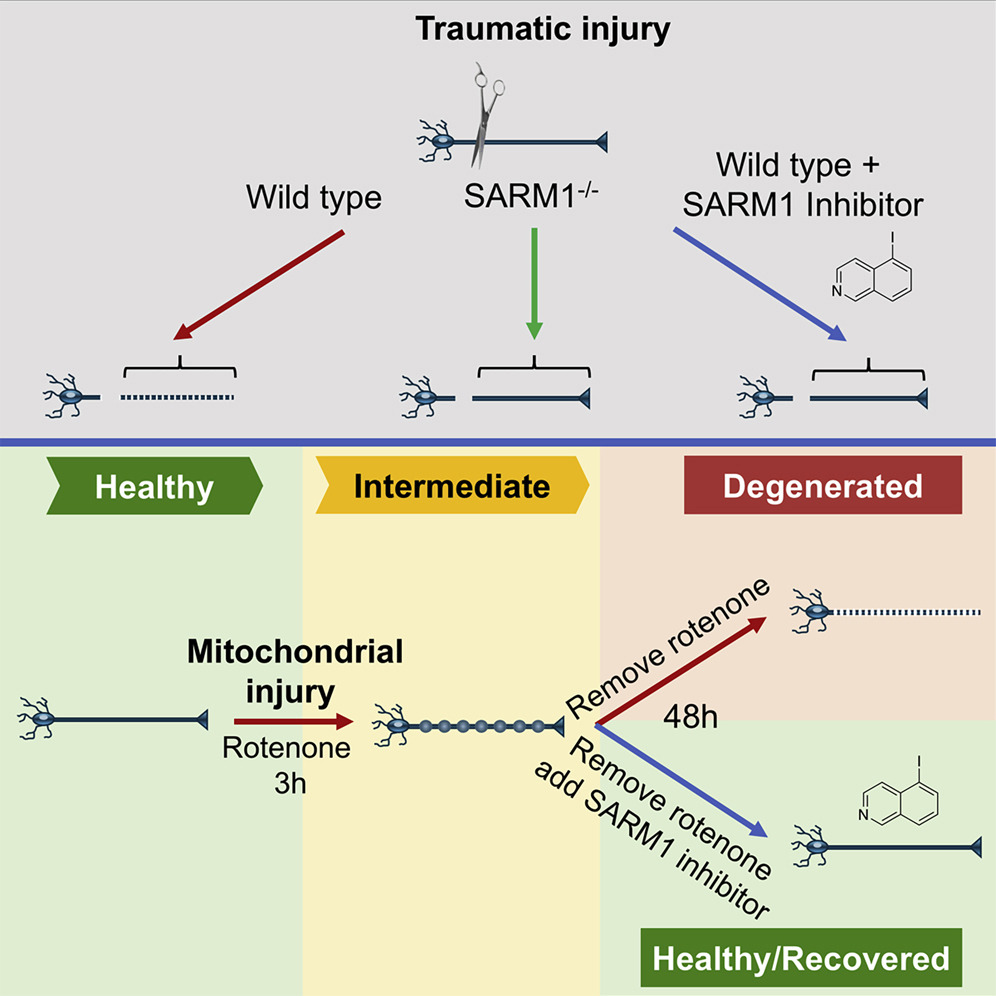Highlights:
- The molecule DSRM-3716 stops SARM1 from breaking down NAD+.
- Blocking SARM1 changes the fate of axon degeneration.
- SARM1 inhibitors have the potential to treat many neurodegenerative diseases.
When a nerve fiber is cut or crushed, the projection withers away starting from the tip and back to the cell body. This process occurs in many neurodegenerative diseases, such as ALS and Alzheimer’s disease, and there’s a lot of research going on trying to pin down ways to stop axon degeneration to save the entire neuron. As reported in Cell Reports, Hughes and colleagues (a collaboration between Disarm Therapeutics, owned by Eli Lilly and Company, and Washington University School of Medicine) have found a molecule that inhibits axon degeneration. The tactic used by Hughes and colleagues to achieve this goal is to block the action of SARM1, a central mediator of axonal degeneration.

DSRM-3716 is a Potent Blocker of SARM1
SARM1 is an enzyme activated in response to cellular injury. When an axon is injured, nicotinamide mononucleotide (NMN) is no longer converted to nicotinamide adenine dinucleotide (NAD+), a vital molecule required for cell and human survival. When NMN is high and NAD+ is low, SARM1 breaks down and decreases NAD+ even further. This metabolic catastrophe leads the axons of neurons to degenerate.
To find how to stop SARM1 from degenerating axons, Hughes and colleagues screened for molecules that could block SARM1 from breaking down NAD+. The American researchers found that SARM1 was inhibited by a molecule called isoquinoline, the derivatives of which have anti-cancer and anti-inflammatory properties. The researchers then strengthened the isoquinoline by chemical modification. The most potent of these isoquinoline SARM1 inhibitors was deemed DSRM-3716.
DSRM-3716 Blocks Axon Degeneration
After identifying DSRM-3716 as a potent blocker of SARM1 activity, Hughes and colleagues tested whether it could stop axon degeneration. Usually, axons degenerate after being cut, so the researchers cut the axons of mouse spinal cord neurons to induce degeneration. Remarkably, DSRM-3716 stopped structural axonal degeneration (as measured by βIII-tubulin) to the same degree as genetically deleting SARM1, demonstrating that DSRM-3716 blocks axon degeneration by inhibiting SARM1. Similar results were observed in human neurons, making these findings more translatable to human neurodegenerative disease.
Upon finding that DSRM-3716 stops the structure of axons from degenerating, Hughes and colleagues determined if the axon’s function could also be preserved. This was to assure that the functional consequences of neurodegeneration could be stopped. To do this, the American researchers assessed the health of the axon’s mitochondria, which are critically important cell organelles required for cell survival. They found that DSRM-3716 treatment prevented the mitochondria from being damaged (as measured by TMRM) even after cutting the axons, confirming that DSRM-3716 blocks axon degeneration.
DSRM-3716 Changes the Fate of Axons
In neurodegenerative diseases like multiple sclerosis, axons can exist in a state between normal and degenerating. Axons in this state are called intermediate axons, and they can potentially be reverted to normal healthy axons. Hughes and colleagues generated intermediate axons by causing slight mitochondrial damage to mouse neurons using a drug called rotenone. By exposing the axons to rotenone, the researchers modeled the intermediate axons found in humans.
Even after removing rotenone, the researchers found that many of the intermediate axons degenerated completely, meaning that the rotenone fated the axons to degenerate. In contrast, treating the axons with DSRM-3716 not only stopped the intermediate axons from degenerating after the removal of rotenone but also helped them recover, ultimately changing their fate. These findings are promising for diseases like MS, whereby SARM1 inhibitors like DSRM-3716 could slow down its progression.

DiSARMing Axon Degeneration
In line with the goals of Disarm Therapeutics, Hughes and colleagues have identified a molecule that can inhibit axon degeneration by blocking SARM1, which could be used to treat neurodegenerative diseases involving axon degeneration. More recently, Disarm Therapeutics in collaboration with Evotec (another biotech company) have found another class of SARM1 inhibitors (isothiazoles). These SARM1 inhibitors blocked axon degeneration in a mouse model for chemotherapy-induced axon degeneration, which also has implications for treating axon degeneration caused by diabetes.
It would seem that currently known SARM1 inhibitors can possibly treat many neurodegenerative diseases. And that’s not all; the scientists of Disarm Therapeutics and Evotec have been very busy, as they may have found a way to come up with even better SARM1 inhibitors. In finding that SARM1 acts as a sensor for detecting changes in NAD+ and NMN, the scientists at Disarm Therapeutics and Evotec showed that NMN and NAD+ compete for a single binding site on SARM1.
When NMN is bound to SARM1, the enzyme is activated. However, when NAD+ is bound to SARM1, the enzyme is inhibited. These findings can help researchers improve the specificity of SARM1 inhibitors, also telling us that even NAD+, or molecules that mimic NAD+ can be used as SARM1 inhibitors. The work of Disarm Therapeutics and other researchers demonstrates the importance of NAD+ metabolism and the balance of NMN and NAD+ in determining the fate of our neurons.